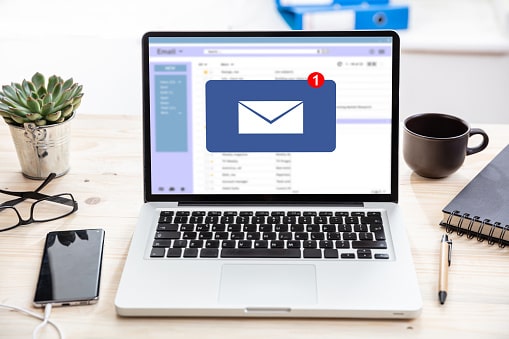Writing emails in English can be daunting, especially for non-native speakers. However, knowing how to write an email in English effectively can improve communication and help you achieve your goals.

Whether you are writing a professional email to a colleague or a personal message to a friend, it is important to use the appropriate language and tone. In this article, we will provide some tips on writing an email in English.
We will cover everything from the basic structure of an email to the language and tone you should use. By the end, you will know how to write effective emails in English that get results.
So without delaying any further, let’s get started!
Tips To Write Emails in English
Below are eight tips for writing an email in English; following these will help you write an email like a pro!
1: Use a Clear Subject Line

Before the recipient opens the mail, the subject line is what they will see in their inbox. If you wish for the mail to be opened and paid attention to, your subject line should be clear and concise. By stating the motive of the email in 3-4 words, you will quickly communicate why you have sent an email.
2: Utilize Separate Personal and Business Email Addresses

Several companies provide employees with a work email address, but if you do not have one, make another account for business purposes. You can maintain formality by sending emails from personal and business accounts separately. Furthermore, it will also be easier for you to manage your professional and personal life.
3: Start with a Greeting

In the next part of the email, you should first greet and then start with the introduction. The best way to greet is to write “Hi” or “Hello,” followed by the name of the person you’re emailing. Writing “Dear” followed by the name is best if the email is informal.
However, if you do not know the person’s name, you can start with “Greetings of the day!”. Further, you can also write “Dear” followed by the recipient’s job title, such as Hiring Manager.
4: Use a Spell Checker Tool

If your email program does not provide the option of spell checks, use an extension of a spell checker tool like Grammarly. These will allow you to correct grammatical mistakes and aid in correcting spelling mistakes.
If you wish to make a positive impact through your email and want it to look professional, then making it error-free should be your priority.
5: Use Short Sentences
Regarding your email style, using short sentences instead of complex, long ones is important. Also, break your email’s body into 2-3 paragraphs. These will help the recipient to understand your mail better and faster. They will also be able to grasp the key points without hassle.
6: Proofread Your Email
The best choice is for a native English speaker to read your email to look for any mistakes or signs of unprofessionalism. However, you may not have anybody to help with the same. In such a case, you must proofread the email before hitting the send button.
You will improve your grammatical and pronunciation skills by reading it aloud. Moreover, you will also be able to find out whenever there’s a gap in the flow. After you’re done proofreading, you can hit the send button with confidence.
7: Recheck the Recipient’s Email Address

One important thing to look for before sending an email is checking the recipient’s email address. You may misspell the address or the name, and your email ends with another recipient.
This means you will keep waiting for a response from the wrong person while the actual one does not even receive the required information.
8: Signature

Adding a signature to your email will make it more professional. Ensure that your emails are set to finish with all the crucial information about you, including your full name, job title, company name, and address, and the link to the company’s website.
Remember to mention your employee ID if you are sending the mail to a senior in the same company. Additionally, you can mention your contact details as well.
Writing the Body of a Formal Email in English
Even after reading the tips mentioned above for writing an email in English, if you still need clarification as to how to write the body of a formal email, do not worry. Given below are three simple steps to help you write a professional email.
1: Mention the Reason for the Email

This section should first state why you are writing to the recipient. You can start your sentence by:
- One of my colleagues lately informed me regarding a job vacancy in your firm…
- You stated in our previous meeting that you wish to concentrate on content strategy, so I recommend that…
- As you might already know, our department is looking for a candidate to…
- I am reaching out to you because…
2: State the Action Required
A majority of emails in professional settings need some action. Thus, mentioning the actions you wish the recipient to take after reading your mail is crucial. These can be written as:
- Would you please review the strategy for the meeting and let me know if you have any recommendations?
- Kindly review the attachments of this email before our next meeting.
- Let me know when you are available this week for a conference meeting.
- Let me know your opinion on my ideas.
3: End with a Closing Statement
Before finishing your email, write a closing statement to ask the reader to respond. Some of the instances are:
- Don’t hesitate to ask me for more time.
- Please let me know if you have any suggestions or feedback regarding my ideas.
- Let me know if you require any clarification.
- Feel free to reach out in case you have any queries.
How is a professional email different?
A professional email is different from a casual email in various ways.
Firstly, the language used in a professional email is more formal and polished, and the tone of the email is respectful and courteous.
Secondly, a professional email contains clear and concise subject lines that provide a brief about the content of the email.
Thirdly, a professional email is usually structured properly, with an introduction, a statement of purpose, a body paragraph, and a conclusion.
Additionally, a professional email is generally free from spelling and grammatical errors, as such errors can impact the credibility and professionalism of the sender.
Lastly, a professional email should always have a signature, including the sender’s name, job title, and contact information.
A professional email is a crucial communication tool for businesses and individuals, and following proper email etiquette is essential for building productive professional relationships.
Related Read;
The Bottom Line
Writing an email in English can be tricky if you are not exactly sure about what you have to write. But once you are clear about the contents of the email, the process becomes more accessible.
All you need to do is write short sentences and maintain the tone, and you’re good to go. Just make sure to be polite and professional, use the right words, keep it brief, and remember to include a signature with your contact info.
